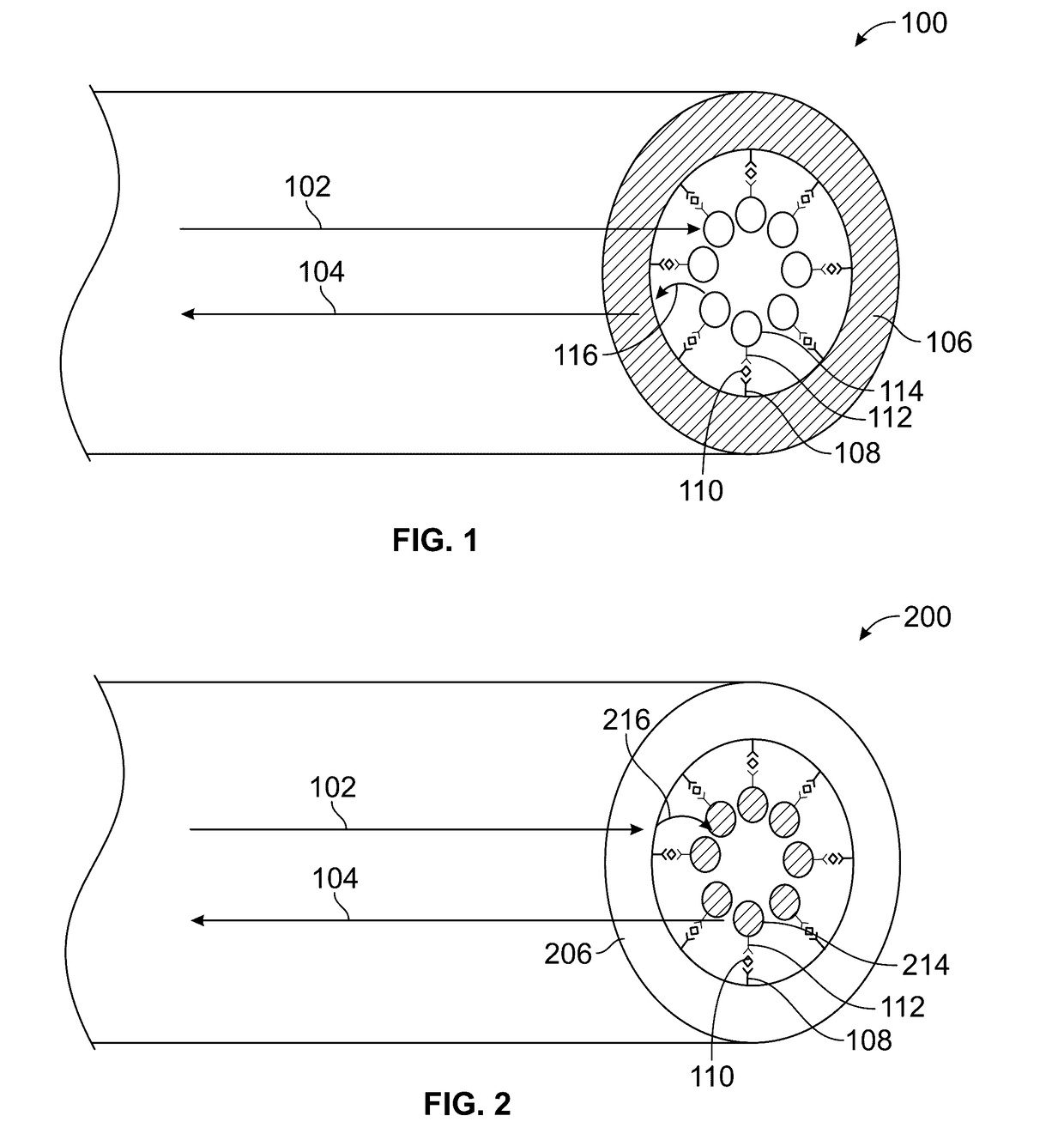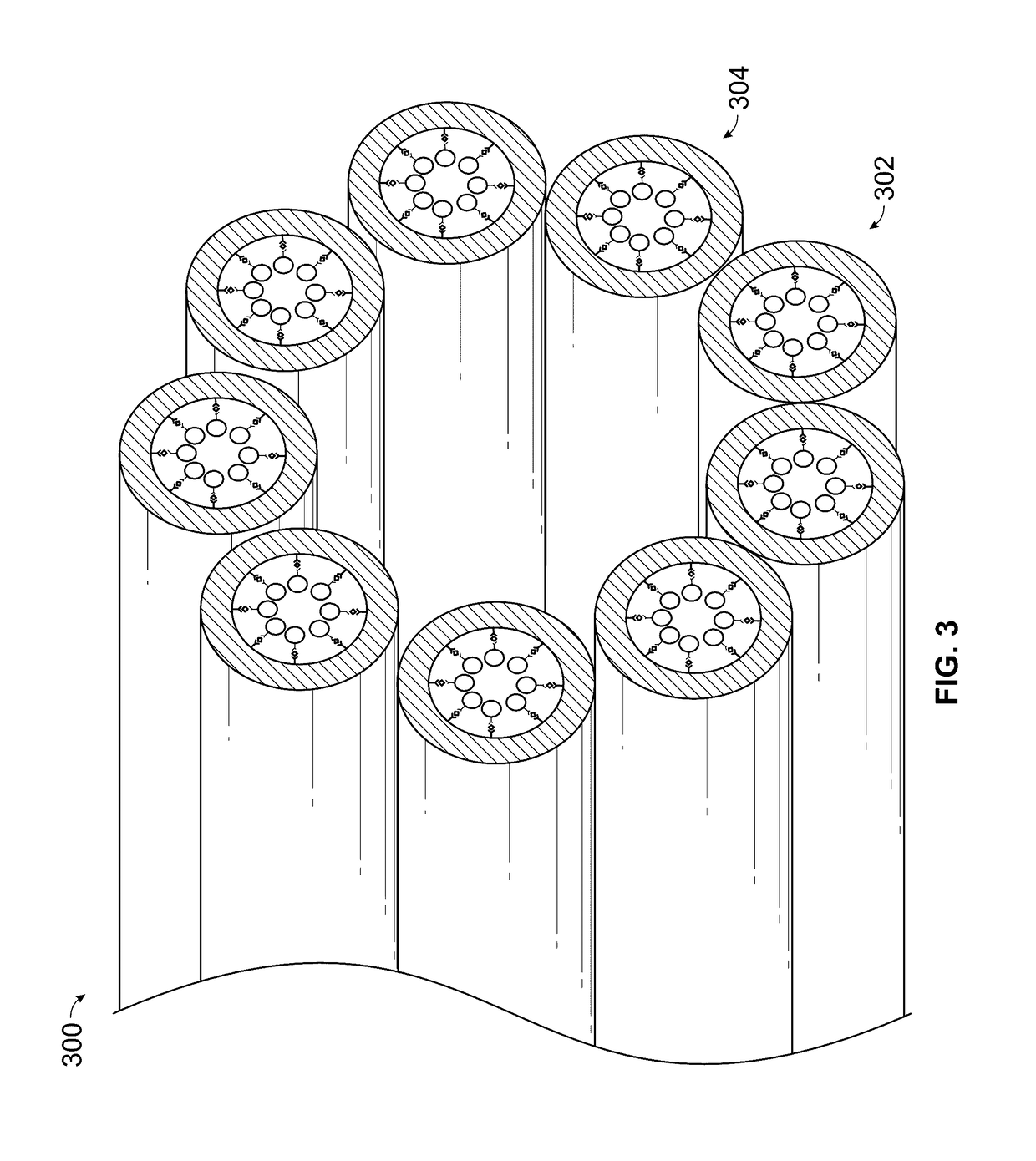Hollow polymer fiber optic system for single analyte and multiplexed analyte detection
a fiber optic system and polymer fiber technology, applied in the field of analyte detection methods, systems and apparatuses, can solve the problems of inability to carry around existing systems that utilize alpha technology, and systems are typically not very accurate, so as to simplify the detection process, simplify the doping process, and the effect of simple and convenient approach
- Summary
- Abstract
- Description
- Claims
- Application Information
AI Technical Summary
Benefits of technology
Problems solved by technology
Method used
Image
Examples
example 1
Preparation of Europium Chelate Eu(NTA)3BINAPO
[0222]Example 1 is an example of a process for preparing a fluorescent compound used in an acceptor dye composition. In the example, the compound is a europium chelate, specifically Eu(NTA)3BINAPO. Other types of europium chelates can also be used as acceptor dyes. In the example process, NTA (4,4,4,-trifluoro-1-(2-naphthyl)-1,3-butadione), (800 mg, 3.0 mmol) and Europium (III)chloride hexahydrate (366 mg, 1.0 mmol) were dissolved together in 10 mL of absolute ethanol along with triethylamine (700 μL, 5 mmol) in a 50 mL round bottom flask to produce a europium-NTA solution. The europium-NTA solution was warmed to 75° C. in an oil bath while stirring for five minutes. BINAPO ([1,1′-binaphthalene]-2,2′-diylbis(diphenylphosphine oxide), (655 mg, 1.0 mmol) was dissolved in 10 mL of absolute ethanol by heating to 75° C. The heated BINAPO-in-ethanol solution was then added, prior to cooling (e.g. while still at a temperature substantially clos...
example 2
Preparation of Eu(NTA)3BINAPO / C28 Thioxene Solution for Dyeing of Hollow Polymer Optical Fibers
[0223]Example 2 is an example of a process for preparing a solution of acceptor dye comprising a chemiluminescent singlet oxygen acceptor and a fluorescent compound. The acceptor dye solution is used for doping a hollow core polymer optic fiber with an acceptor dye composition (e.g. an acceptor dye composition comprising a chemiluminescent singlet oxygen acceptor and a fluorescent compound). In the example, the acceptor dye solution comprises a europium chelate, Eu(NTA)3BINAPO, and C28 thioxene. The C28 thioxene is a chemiluminescent singlet oxygen acceptor and the europium chelate is a fluorescent compound. In the example, Eu(NTA)3BINAPO (160 mg, 0.10 mmol) was dissolved in 3.2 mL of 2-ethoxyethanol to a final concentration of 50 mg / mL with the aid of heating to 70° C. Separately, C28 thioxene (4-(2-phenyl-5,6-dihydro-1,4-oxathiin-3-yl)-N,N-ditetradecylaniline), (80 mg, 0.12 mmol) was dis...
example 3
Multi-Hole Hollow Polymer Optical Fiber for Increasing Binding Surface Area
[0224]Example 3 is an example of a multi-core hollow polymer optical fiber, comprising multiple hollow cores (e.g. hollow channels within the fiber). The multi-core hollow polymer optical fiber provides for increased available surface area for analyte binding, and as well as decreased distance that an analyte or assay reagent needs to diffuse in order to reach the surface of the hollow polymer optical fiber. FIG. 15 is an image of a multi-core hollow polymer optical fiber. FIG. 15B is another image of the multi-core hollow polymer optic fiber. FIG. 15C is an image of an end facet of the multi-core hollow polymer optic fiber showing the multiple hollow cores of the fiber.
[0225]The multi-core hollow polymer optical fiber in this example is made of polystyrene, has an outer diameter of 1.3 mm and comprises 19 hollow channels of inner diameter of 105 μm, each of which was dyed with acceptor dye composition(e.g. c...
PUM
 Login to View More
Login to View More Abstract
Description
Claims
Application Information
 Login to View More
Login to View More - R&D
- Intellectual Property
- Life Sciences
- Materials
- Tech Scout
- Unparalleled Data Quality
- Higher Quality Content
- 60% Fewer Hallucinations
Browse by: Latest US Patents, China's latest patents, Technical Efficacy Thesaurus, Application Domain, Technology Topic, Popular Technical Reports.
© 2025 PatSnap. All rights reserved.Legal|Privacy policy|Modern Slavery Act Transparency Statement|Sitemap|About US| Contact US: help@patsnap.com



